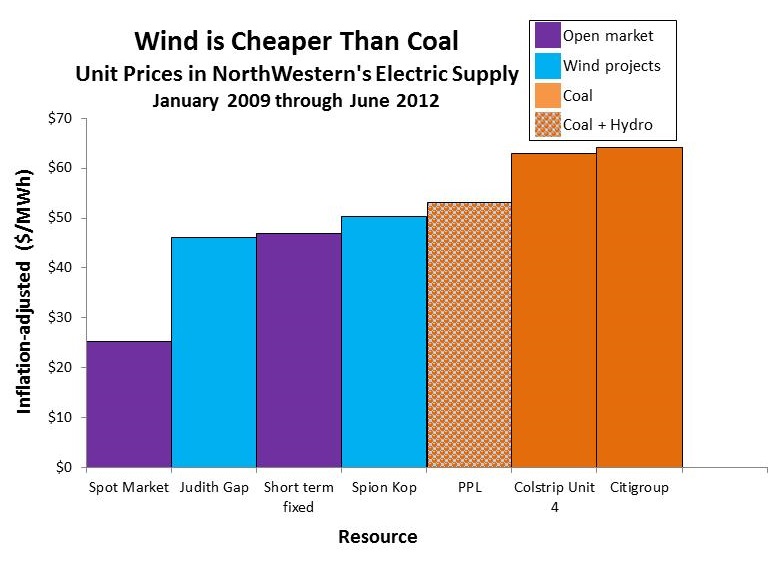Quietly, something huge is happening in Montana. Electricity from wind plants is now cheaper than coal-fired electricity. And this is according to data on file with the Montana Public Service Commission (MT PSC)—the official body that regulates Montana’s electric utilities. This went relatively unnoticed in the media since the MT PSC posted a summary of this data on its website in December, but if this changing of the guard happens on a broader scale, our old assumptions about the economics of solving climate change will be shaken to their core.
The chart below shows selected unit prices of selected sources in Montana from January 2009 through June 2012. During that timeframe, the sources on this chart made up about three-quarters of NorthWestern Energy’s electric supply. This chart shows that NorthWestern’s wind suppliers (blue) came in at a lower rate ($/MWh) than electricity from coal-fired generation (orange).
These prices are based on actual project cost (adjusted for inflation) and actual megawatt-hours delivered. They include current policy costs and benefits, but also assign a substantial share of the costs for a new natural gas facility to the wind projects, as the new gas plant is used a balancing resource for the variable power from the wind farms. The purple bars represent contract prices for electricity bought up to a year-and-a-half ahead of time (“short-term fixed”) and an hour ahead of time (“spot market”). It is useful to note that wind power usually has a near-zero marginal production cost since it costs almost nothing to run a wind turbine once it’s already built (no fuel cost), which means the additional wind on the system may be lowering spot market prices by displacing resources with higher variable costs.
Popular claims suggest that utilities and their customers cannot possibly pay the ‘extra cost’ of renewables, but this data shows that—even with integration costs embedded—wind is cheaper than coal in Montana. What’s more, renewables are extremely stable over the long-term; once built, they cost almost nothing to operate, and are not beholden to volatile fuel prices.
This post was originally written as a brief report by Sonia Aggarwal. Click here for the PDF version of this post, which includes sources and endnotes.

